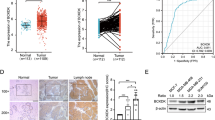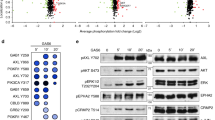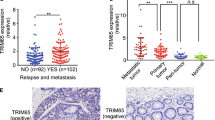Abstract
Tumor metastasis is responsible for most cancer patients’ deaths. Understanding the mechanism of metastasis is crucial for improving the cure rate for cancer. Here, we report that Gankyrin, a chaperone of ubiquitin–proteasome, has an essential role in breast cancer metastasis. We find that Gankyrin is highly overexpressed in human breast cancers and the expression correlates strongly with lymph node metastasis. Knocking down Gankyrin expression in highly metastatic human breast cancer cells significantly decreases cancer cell migration and invasion. Furthermore, we demonstrate that depletion of Gankyrin inhibits intrinsic Rac1 activity and induces large focal adhesions. Overexpression of Gankyrin accelerates focal adhesion turnover and increases cell migration. Notably, reduction of Gankyrin expression in mouse mammary tumor cell significantly decreases tumor metastasis to lung in animal models. Therefore, our findings suggest that Gankyrin is crucial for breast cancer metastasis and highlight the potential of Gankyrin as a therapeutic target for tumor metastasis.
This is a preview of subscription content, access via your institution
Access options
Subscribe to this journal
Receive 50 print issues and online access
$259.00 per year
only $5.18 per issue
Buy this article
- Purchase on Springer Link
- Instant access to full article PDF
Prices may be subject to local taxes which are calculated during checkout






Similar content being viewed by others
Abbreviations
- RhoGDI:
-
Rho guanine nucleotide dissociation inhibitor
- ROCK:
-
Rho-associated coiled coil-containing protein kinase
- shRNA:
-
short hairpin RNA
- siRNA:
-
small interfering RNA.
References
Christofori G . New signals from the invasive front. Nature 2006; 441: 444–450.
Hanahan D, Weinberg RA . The hallmarks of cancer. Cell 2000; 100: 57–70.
Mareel M, A. Leroy . Clinical cellular, and molecular aspects of cancer invasion. Physiol Rev 2003; 83: 337–376.
Steeg PS . Tumor metastasis: mechanistic insights and clinical challenges. Nat Med 2006; 12: 895–904.
Parsons JT, Horwitz AR, Schwartz MA . Cell adhesion: integrating cytoskeletal dynamics and cellular tension. Nat Rev Mol Cell Biol 2010; 11: 633–643.
Etienne-Manneville S, Hall A . Rho GTPases in cell biology. Nature 2002; 420: 629–635.
Hall A . Rho GTPases and the actin cytoskeleton. Science 1998; 279: 509–514.
Frank SR, Adelstein MR, Hansen SH . GIT2 represses Crk- and Rac1-regulated cell spreading and Cdc42-mediated focal adhesion turnover. EMBO J 2006; 25: 1848–1859.
Hirsch DS, Shen Y, Wu WJ . Growth and motility inhibition of breast cancer cells by epidermal growth factor receptor degradation is correlated with inactivation of Cdc42. Cancer Res 2006; 66: 3523–3530.
Wang SE, Shin I, Wu FY, Friedman DB, Arteaga CL . HER2/Neu (ErbB2) signaling to Rac1-Pak1 is temporally and spatially modulated by transforming growth factor beta. Cancer Res 2006; 66: 9591–9600.
Yang C, Liu Y, Lemmon MA, Kazanietz MG . Essential role for Rac in heregulin beta1 mitogenic signaling: a mechanism that involves epidermal growth factor receptor and is independent of ErbB4. Mol Cell Biol 2006; 26: 831–842.
Keely PJ, Westwick JK, Whitehead IP, Der CJ, Parise LV . Cdc42 and Rac1 induce integrin-mediated cell motility and invasiveness through PI(3)K. Nature 1997; 390: 632–636.
Minard ME, Kim LS, Price JE, Gallick GE . The role of the guanine nucleotide exchange factor Tiam1 in cellular migration, invasion, adhesion and tumor progression. Breast Cancer Res Treat 2004; 84: 21–32.
Dawson S, Higashitsuji H, Wilkinson AJ, Fujita J, Mayer RJ . Gankyrin: a new oncoprotein and regulator of pRb and p53. Trends Cell Biol 2006; 16: 229–233.
Higashitsuji H, Itoh K, Nagao T, Dawson S, Nonoguchi K, Kido T et al. Reduced stability of retinoblastoma protein by gankyrin, an oncogenic ankyrin-repeat protein overexpressed in hepatomas. Nat Med 2000; 6: 96–99.
Tang S, Yang G, Meng Y, Du R, Li X, Fan R et al. Overexpression of a novel gene gankyrin correlates with the malignant phenotype of colorectal cancer. Cancer Biol Ther 2010; 9: 88–95.
Ortiz CM, Ito T, Tanaka E, Tsunoda S, Nagayama S, Sakai Y et al. Gankyrin oncoprotein overexpression as a critical factor for tumor growth in human esophageal squamous cell carcinoma and its clinical significance. Int J Cancer 2008; 122: 325–332.
Man JH, Liang B, Gu YX, Zhou T, Li AL, Li T et al. Gankyrin plays an essential role in Ras-induced tumorigenesis through regulation of the RhoA/ROCK pathway in mammalian cells. J Clin Invest 2010; 120: 2829–2841.
DerMardirossian C, Bokoch GM . GDIs: central regulatory molecules in Rho GTPase activation. Trends Cell Biol 2005; 15: 356–363.
Boulter E, Garcia-Mata R, Guilluy C, Dubash A, Rossi G, Brennwald PJ et al. Regulation of Rho GTPase crosstalk, degradation and activity by RhoGDI1. Nat Cell Biol 2010; 12: 477–483.
Fukata M, Kaibuchi K . Rho-family GTPases in cadherin-mediated cell-cell adhesion. Nat Rev Mol Cell Biol 2001; 2: 887–897.
Yang S, Zhang JJ, Orai1 Huang XY . and STIM1 are critical for breast tumor cell migration and metastasis. Cancer Cell 2009; 15: 124–134.
Webb DJ, Parsons JT, Horwitz AF . Adhesion assembly, disassembly and turnover in migrating cells—over and over and over again. Nat Cell Biol 2002; 4: E97–100.
Webb DJ, Donais K, Whitmore LA, Thomas SM, Turner CE, Parsons JT et al. FAK-Src signalling through paxillin, ERK and MLCK regulates adhesion disassembly. Nat Cell Biol 2004; 6: 154–161.
Katsumi A, Milanini J, Kiosses WB, del Pozo MA, Kaunas R, Chien S et al. Effects of cell tension on the small GTPase Rac. J Cell Biol 2002; 158: 153–164.
Sanz-Moreno V, Gadea G, Ahn J, Paterson H, Marra P, Pinner S et al. Rac activation and inactivation control plasticity of tumor cell movement. Cell 2008; 135: 510–523.
Jin BF, He K, Wang HX, Bai B, Zhou T, Li HY et al. Proteomics analysis reveals insight into the mechanism of H-Ras-mediated transformation. J Proteome Res 2006; 5: 2815–2823.
Roelofs J, Park S, Haas W, Tian G, McAllister FE, Huo Y et al. Chaperone-mediated pathway of proteasome regulatory particle assembly. Nature 2009; 459: 861–865.
Saeki Y, Toh EA, Kudo T, Kawamura H, Tanaka K . Multiple proteasome-interacting proteins assist the assembly of the yeast 19S regulatory particle. Cell 2009; 137: 900–913.
Higashitsuji H, Itoh K, Sakurai T, Nagao T, Sumitomo Y, Masuda T et al. The oncoprotein gankyrin binds to MDM2/HDM2, enhancing ubiquitylation and degradation of p53. Cancer Cell 2005; 8: 75–87.
Sun W, Ding J, Wu K, Ning BF, Wen W, Sun HY et al. Gankyrin-mediated dedifferentiation facilitates the tumorigenicity of rat hepatocytes and hepatoma cells. Hepatology 2011; 54: 1259–1272.
Lee K, Liu Y, Mo JQ, Zhang J, Dong Z, Lu S . Vav3 oncogene activates estrogen receptor and its overexpression may be involved in human breast cancer. BMC Cancer 2008; 8: 158.
Ridley AJ . Rho GTPases and cell migration. J Cell Sci 2001; 114: 2713–2722.
Machacek M, Hodgson L, Welch C, Elliott H, Pertz O, Nalbant P et al. Coordination of Rho GTPase activities during cell protrusion. Nature 2009; 461: 99–103.
Pan X, Zhou T, Tai YH, Wang C, Zhao J, Cao Y et al. Elevated expression of CUEDC2 protein confers endocrine resistance in breast cancer. Nat Med 2011; 17: 708–714.
Wu K, Katiyar S, Li A, Liu M, Ju X, Popov VM et al. Dachshund inhibits oncogene-induced breast cancer cellular migration and invasion through suppression of interleukin-8. Proc Natl Acad Sci USA 2008; 105: 6924–6929.
Li Z, Wang C, Jiao X, Katiyar S, Casimiro MC, Prendergast GC et al. Alternate cyclin D1 mRNA splicing modulates p27KIP1 binding and cell migration. J Biol Chem 2008; 283: 7007–7015.
Minn AJ, Gupta GP, Siegel PM, Bos PD, Shu W, Giri DD et al. Genes that mediate breast cancer metastasis to lung. Nature 2005; 436: 518–524.
Acknowledgements
This work was supported by grants from the Major Research Plan of the National Natural Science Foundation of China (No.91029733), National Basic Research Program of China (2012CB910700), China National Natural Science Foundation (No. 81001174 and No. 81171918), Beijing Municipal Science and Technology Commission (2010B040).
Author information
Authors and Affiliations
Corresponding authors
Ethics declarations
Competing interests
The authors declare no conflict of interest.
Additional information
Supplementary Information accompanies the paper on the Oncogene website
Supplementary information
Rights and permissions
About this article
Cite this article
Zhen, C., Chen, L., Zhao, Q. et al. Gankyrin promotes breast cancer cell metastasis by regulating Rac1 activity. Oncogene 32, 3452–3460 (2013). https://doi.org/10.1038/onc.2012.356
Received:
Revised:
Accepted:
Published:
Issue Date:
DOI: https://doi.org/10.1038/onc.2012.356
Keywords
This article is cited by
-
Metabolic enzyme LDHA activates Rac1 GTPase as a noncanonical mechanism to promote cancer
Nature Metabolism (2022)
-
The oncogene Gankyrin is expressed in testicular cancer and contributes to cisplatin sensitivity in embryonal carcinoma cells
BMC Cancer (2019)
-
Proteomic profiling of human cancer pseudopodia for the identification of anti-metastatic drug candidates
Scientific Reports (2018)
-
Parkin targets HIF-1α for ubiquitination and degradation to inhibit breast tumor progression
Nature Communications (2017)
-
Proteasome dysregulation in human cancer: implications for clinical therapies
Cancer and Metastasis Reviews (2017)



